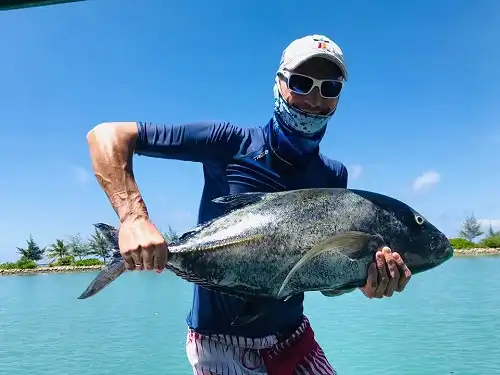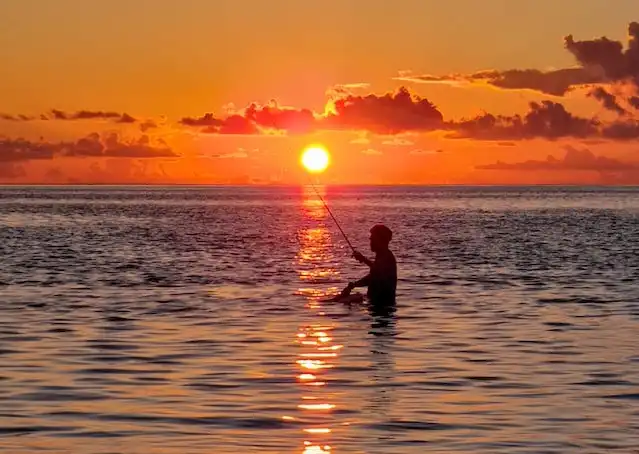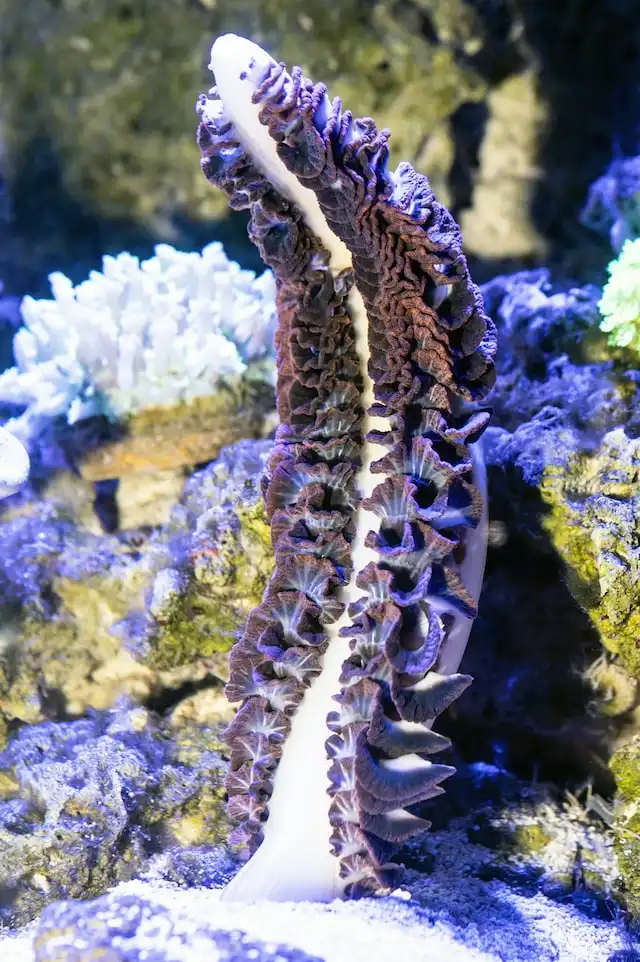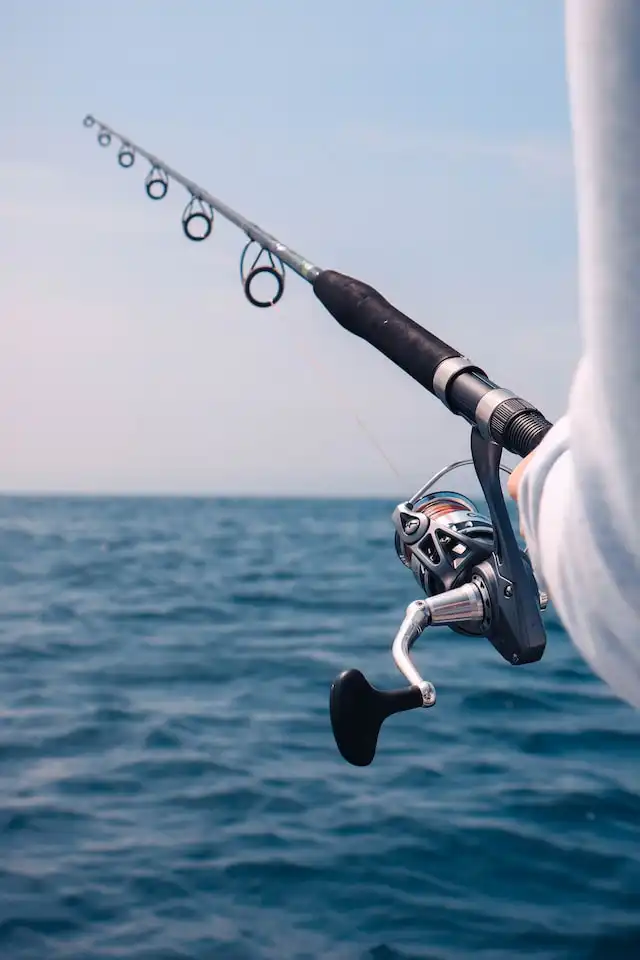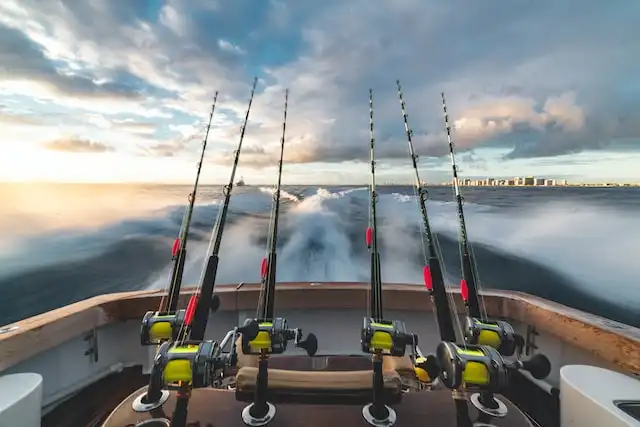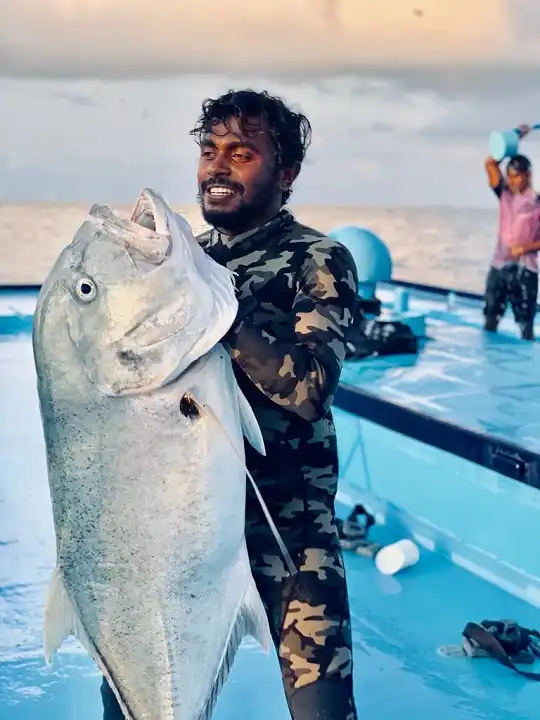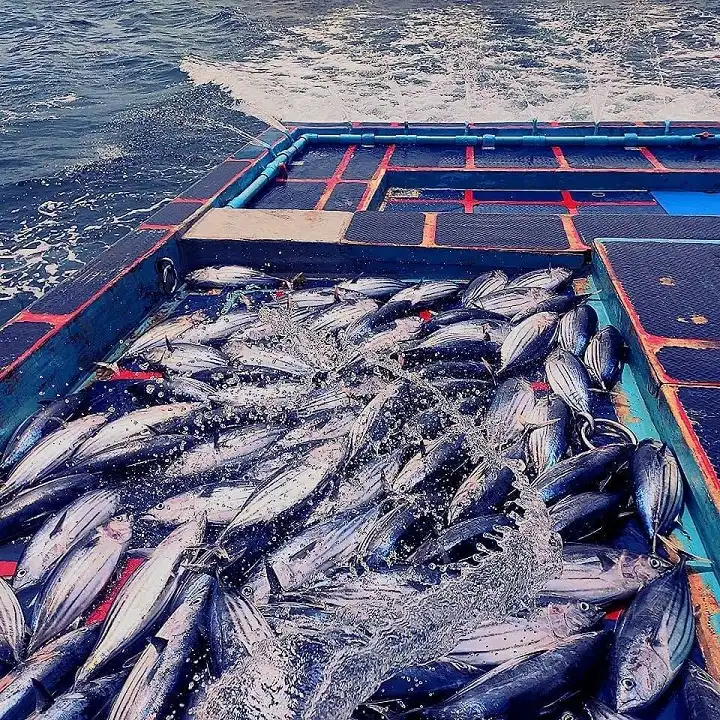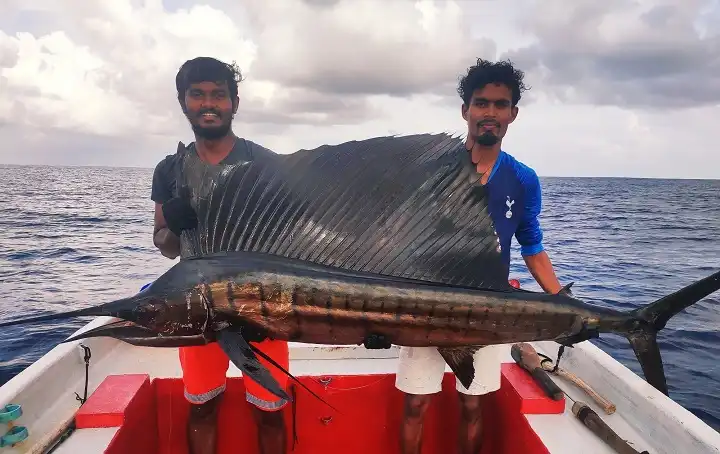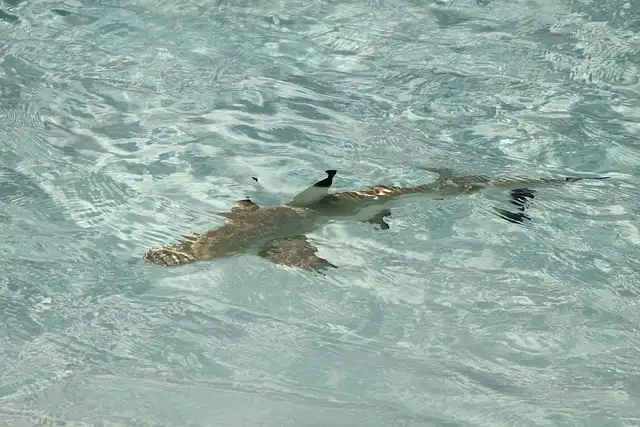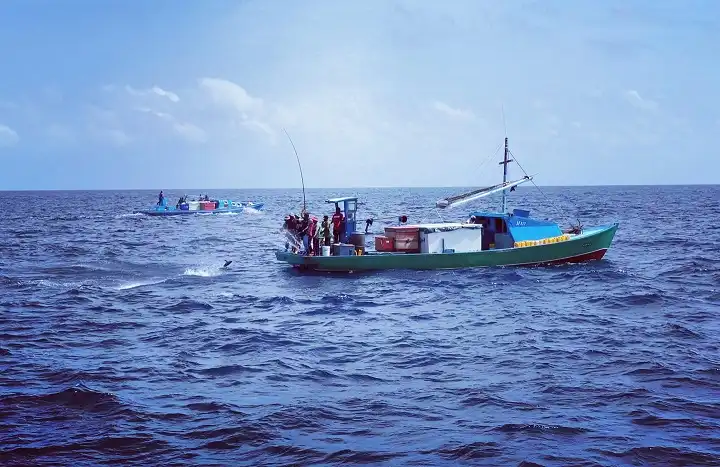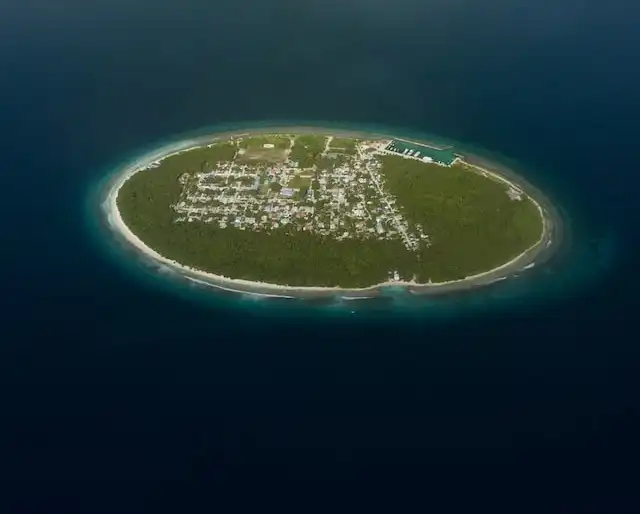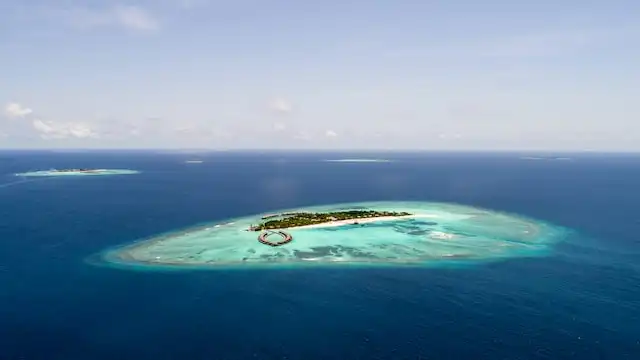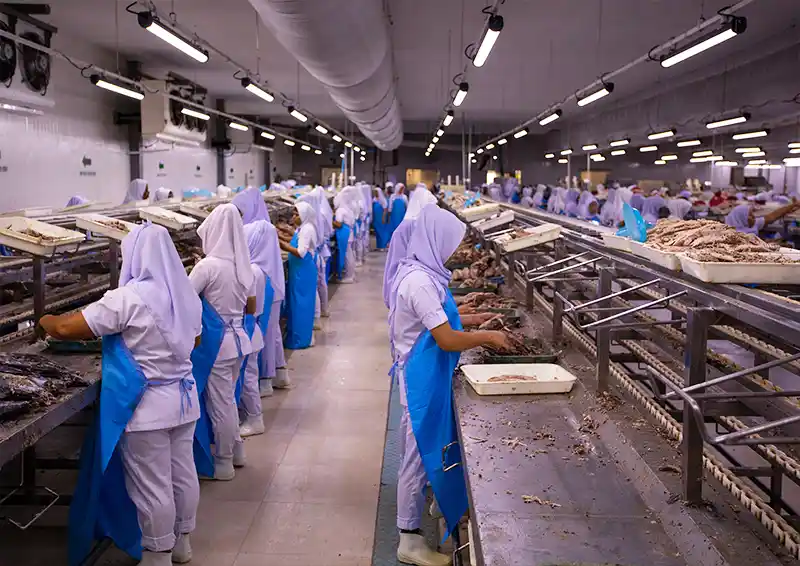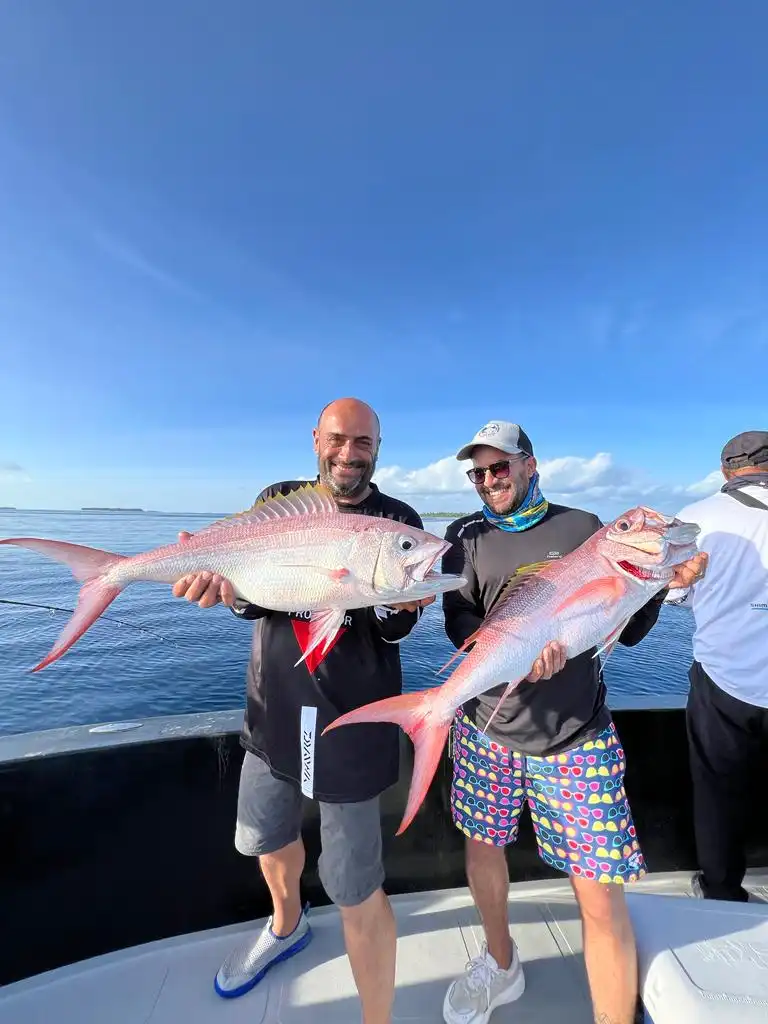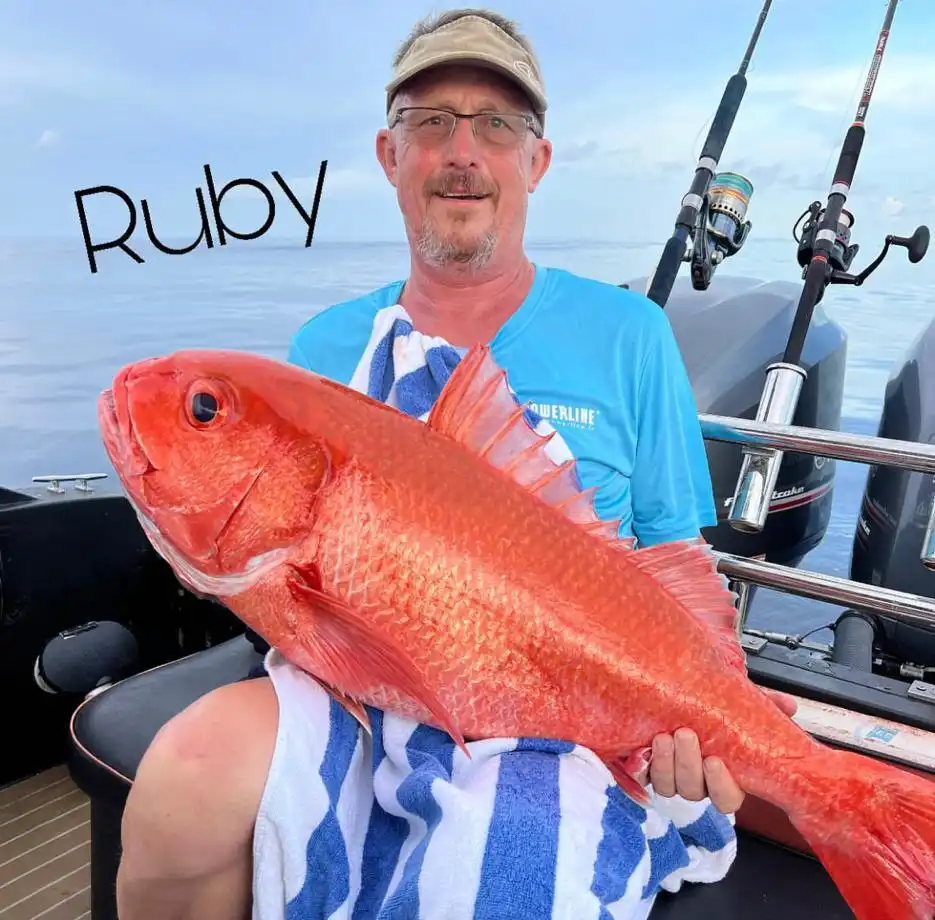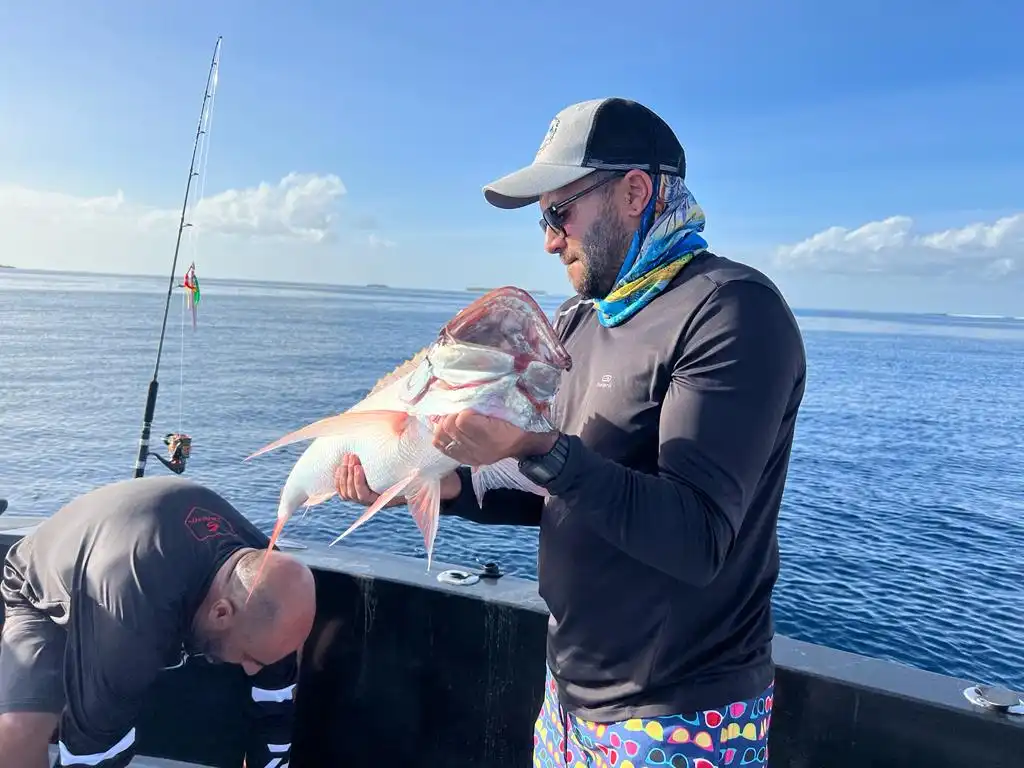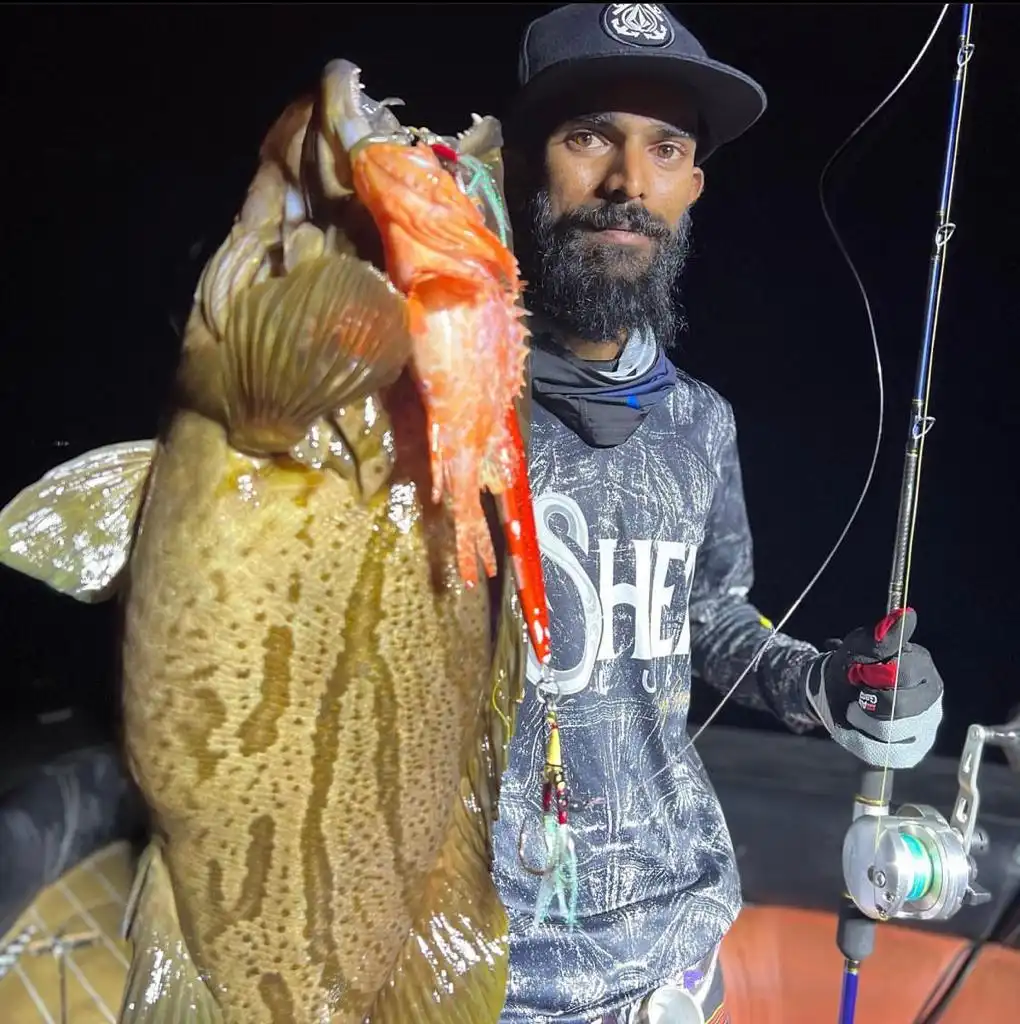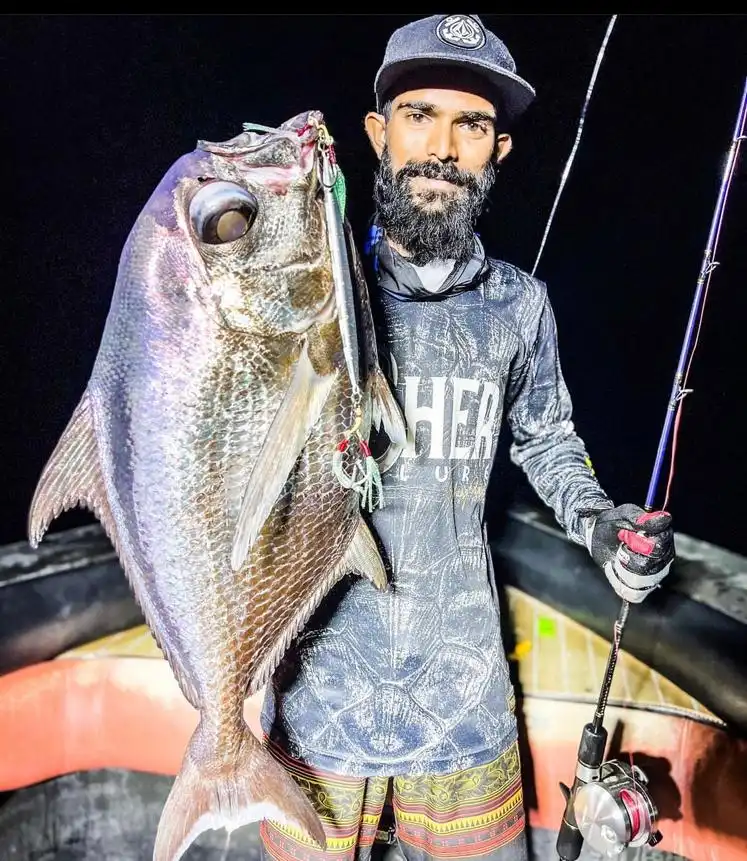Fishing in Maldives
Types of Fishing
Types of Fishes
Fishing Map
Fishing History
Protected Species
Exclusive Economic Zone (EEZ)
Best Time To Go
Places To Go
Banned Methods
MIFCO (Fishing Industry)
Exploitation and Overfishing
The Catch
Worldwide Fishing Methods
Fishing Videos
Fishing Seasons
FAQs
A Maldives fishing tour is a wonderful way to spend your vacation in the Maldives. Fishing in Maldives is a fantastic experience that many people wish to have. The azure ocean water lends a symbolic appearance to this idyllic island. As a result, you can't afford to pass up the opportunity to visit the Maldives. You'll not only be able to take in the scenery, but you'll also be able to sample several delectable fish in Maldives, making your trip much more enjoyable.
The Maldives are known for their clear waters, pristine sands, and opulent hotels. Over a thousand coral islands make up this magnificent global stretch, which has long been a dream destination for honeymooners and nature enthusiasts.
Fish is the primary source of protein in the Maldives, and it is a mainstay of the indigenous diet. And, believe it or not, fishing in maldives is a popular pastime on both among visitors and natives. However, finding the perfect Maldives fishing package or fishing area can be difficult for a foreigner.

The Maldives employs a range of fishing techniques, from reef and bait fishing to pelagic fishing, which accounts for the majority of industry revenue. Because of the distance between the islands in the Maldives, you may have to fish from wherever you are staying. You may fish in the Maldives using a variety of ways, whether from a boat or from the beach.
If you've come to enjoy big game or reef fishing, charter boat fishing is your best bet. You may select from containers of various shapes and sizes. The Maldives has it all, whether it's sailing in grandeur on a sumptuous mega-yacht or stepping aboard a traditional dhoni.
Go on a liveaboard charter for a truly unforgettable experience. This is an excellent way to "hop" islands and explore the deeper waters beyond. Your fishing license and equipment are usually included in most trips. Even so, it's a good idea to double-check with your captain forehand to make sure you're getting what you deserve.
Shore fishing in the Maldives may also be a rewarding experience if you just have a short amount of time. Just be sure it's permitted. To preserve the native reefs, the Maldives take marine conservation extremely seriously. So, there are rigorous guidelines. This includes a strict prohibition on shore fishing from Maldive resorts, unless you have the management of the hotel's express consent.
In the Maldives, this is a one-of-a-kind fishing experience. This fishing adventure is exclusive to the Maldives. You'll venture out long after the sun has gone down to fish for nocturnal species under the stars. These expeditions are conducted on traditional dhoni fishing boats, and handline fishing techniques are mostly employed. It doesn't get much more genuine than that!
Night fishing is one of the most amazing fishing adventures in the Maldives. They're not too long, and you won't be bothered by the intense sunshine. Millions of dazzling stars illuminate the tropical night sky on a clear night, and you can see where the sky ends and the water begins. Fish like barracudas, snappers, emperors, and squirrel fish can be caught at night. Night fishing outings are a lot of fun.
In the Maldives, a variety of bait fishing techniques are employed, with nighttime fishing with lights being the most popular.
Reef fishing is catching reef fish and other species that dwell on coral reefs and within atoll basins. The Maldives is home to 5 percent of the world's coral reefs and produces more than 40,000 tonnes of commercial reef fish every year. The atoll basins, which constitute by far the majority of the Maldivian atolls, are known to contain the most plentiful reef fish resources, although deep reef slopes beyond the atolls sustain certain high-value species, but their overall potential yield is rather minor.
Grouper, snapper, emperor, and reef-associated jack are the most popular fish obtained in the reef fishing business, and they are all captured using old fishing methods such as handline and longline fishing. Some anglers prefer feathered hooks with no bait for catching Green Jobfish. The grouper fishing industry, on the other hand, has come under pressure due to increased demand from local tourism and international markets, and while it has been sustainable up to this point, there is little room for expansion under current fishing practises, which threaten to significantly deplete grouper stocks.
Other reef resources include aquarium fish species, of which around 100 are taken for export, accounting for more than 75 percent of the trade, including endangered species vulnerable to over-exploitation. Cyanide fishing, which includes spraying a sodium cyanide mixture into the intended fish's habitat to paralyse the fish, is occasionally conducted. This not only harms other species that dwell in and around the region, but it also harms the ecosystem in which they exist.
fishery earning the most revenue of any reef fishing group. They are mostly captured for shipment to the East and are still abused.Sharks have been fished in the Maldives for millennia, with the reef shark.
Other resources taken from the reef include lobster, squid, cowrie, and cuttlefish (primarily for the tourism industry), red and black coral (heavily exploited), and sea cucumber, which has recently seen an increase in export to the East but is on the verge of extinction if current fishing practises continue.
Pole and line fishing for tuna is a popular pastime in the Maldives. Even for commercial fishing, which is uncommon. It's one of the most environmentally friendly methods of catching fish since you'll be hooking them one by one. This implies that no other fish will be harmed in the process. And the equipment required is minimal: a single hooked line on a pole.
The vessel is the one who makes the magic happen. When you locate a school of fish, the rear of the boat sprays water, scattering little bait fish across the surface. This causes the fish to go into a feeding frenzy. However, you will not be confined to merely pole and line fishing. Fly fishing, trolling, jigging, and popping are also available on a regular basis.
Pelagic fishing entails catching pelagic species that reside offshore in the open ocean, such as bait or forage fish like anchovies and herring, as well as bigger fish that feast on them like tuna, swordfish, barracuda, and ocean sharks.
The Maldives' primary fishing business is tuna fishing, with many species harvested for both local and export uses, the majority of which are skipjack and yellowfin tuna. Tuna are taken using a number of methods, including conventional pole-and-line, hand-line, and long-line fishing, with pole-and-line accounting for up to 90% of total fish catch. This ancient method of fishing with a pole and line is the most environmentally benign and has helped to the sustainability of tuna resources by allowing harvest levels to be near to their maximum sustainable yield.
Maldivian fisherman use bamboo or plastic poles between 10 and 15 feet long, with a line and a feathery barbless hook connected to the smaller end of the pole. These poles can handle up to 50 pounds of fish. Forage fish like anchovies or herring are impaled on the hook and used as tuna bait.
Mariculture is the culture of marine organisms in seawater, and the Maldives has a sizable mariculture business due to the islands' inability to support inland fisheries or land-based aquaculture operations. Maritime activities include gigantic clam culture, pearl culture, spiny lobster culture, sea cucumber culture, bêche-de-mer culture, and grouper culture.
Jigging is a fun fishing method since it allows you to get close to the fish you're catching. You'll need to use your fishing pole wisely in this situation. As a result, it is one of the most popular fishing destinations in the Maldives. This fishing approach targets enormous fish such as tuna, red bass, and gigantic trevally, which are similar to those caught while shore fishing.
Big game fishing is an excellent option for guests seeking for a thrill. On this fishing excursion, you'll work with professional anglers to capture marlin, tuna, wahoo, mahi-mahi, and other species of fish. The duration of a big game fishing package can range from two to twenty-four hours, and it can be a very rewarding fishing excursion.
The giant trevally is the common fish species on every bucket list, and many visitors often dedicate their entire vacation to hooking one. The Maldives are among rare places in the world where you can catch giant trevally year-round, both on the reef and over the flats.
The larger fish, which may weigh between 30 and 80 pounds, gather on the reefs. Therefore, jigging and popping, two of the most common fishing techniques in the Maldives, are perfect for testing out when pursuing GTs. The same holds true for fishing over flats, with the exception that the fish are smaller and often weigh between 10 and 15 pounds. However, fly fishermen won't mind because the area's shallow, clear waters are ideal for sight casting.
Tuna fishing is significant in the Maldives for a variety of reasons. A large number of gigantic Yellowfin tuna can be found, as well as a steady supply of Dogtooth and Skipjack tuna. They are vital to the local economy and attract a large number of fishermen to the nation for recreational fishing. Trying out classic tuna fishing tactics is one of the most exciting aspects of tuna fishing.
The vessel is where the magic happens. Once you've located a school of fish, the back of the boat sprays water on the surface, scattering the small baitfish. This sends the entire school of fish into a feeding frenzy.
The Maldives are made up of reefs, both physically and symbolically. Coral, which formed the islands themselves, is also to blame for the variety of marine life there. As a result, reef fishing is the primary type of fishing available in the Maldives, which is fine by visiting fishermen. The variety of species you can capture is endless and includes groupers, red emperors, sweetlip emperors, jobfish, squirrelfish, jacks, and much more.
You'll mostly bottom fish while you're out at the reefs. Both deep drop jigging and live bait are popular methods for catching tasty fish. Release the remainder and keep any fish you intend to consume that day. The Maldives' tourism business depends heavily on coral reefs and a robust fish population.
Pelagic fish live in the pelagic zone of ocean or lake waters, where they are neither close to the bottom nor near the shore, in contrast to demersal fish, which live on or near the bottom, and reef fish, which live on coral reefs. You may pursue some of the most sought-after pelagic species in the world when deep sea fishing in the Maldives. You may also go for Wahoo, Mahi Mahi, Sailfish, and Marlin in addition to Tuna. Although there isn't really an off-season in the Maldives, November to March are the ideal months for big game fishing.
The "dry" or "northeast monsoon" season is now in effect. It is simple to use well-known tactics like jigging, popping, and trolling since the sky and the water are calm. What else is there to say? Few places, let alone in a setting as beautiful as the Maldives, can boast a list of large game fish this extensive.
Groupers are fish that belong to the Epinephelinae subfamily of the Serranidae family of the order Perciformes. The serranid family contains the sea basses, however not all serranids are termed "groupers." The term "grouper" is mainly applied to fish belonging to one of two big genera.
Due to the size and strength of the four marlin species, as well as their relative rarity, some game fisherman consider marlin fishing to be the pinnacle of offshore game fishing.
The reef shark, which may grow to be 3 meters (9.8 feet) long and eat on a variety of fish and cephalopods, is one of the largest apex predators in the reef environment. They've been observed sitting stationary on the seafloor or within caves, which is rare for a swimming shark. If it feels threatened, it may make a threat show by rapidly changing course and dipping its pectoral fins. It is viviparous, with females giving birth to 4–6 pups every other year, similar to other requiem sharks.
The bigeye barracuda (Sphyraena forsteri) belongs to the Sphyraenidae family and may be found in the Indo-West Pacific.
The green jobfish, also known as the gray jobfish, gray snapper, or thin snapper, and uku in Hawaiian, is a ray-finned snapper belongs to the Lutjanidae family of marine ray-finned fish. It may be found throughout the Indo-Pacific.
Fishing has historically been the Maldives' principal source of wealth, with tuna fishing being the most lucrative. The Maldives used to transport up to 90% of its fishing catch to Sri Lanka, which was largely tuna in dried form. When Sri Lanka restricted the import of such fish in the 1970s, the Maldives teamed up with the Japanese Marubeni Corporation to develop the Maldives Nippon Corporation, a canning and processing company that cans and processes fresh fish. The Maldivian government also established the Maldives Industrial Fisheries Company in 1979, which is responsible for the processing, exporting, and collection of frozen and canned tuna, as well as providing collection vessels.
Several fisheries development projects involving massive upgrades in harbor and refrigerated facilities were completed with financial help from Japan and the World Bank in the 1980s, resulting in a rise in canned fish earnings. The fishing industry dominated the economy until 1985, when the tourist industry eclipsed the fishing industry in terms of GDP contribution. However, the fishing industry continues to provide a vital source of income for over 20% of the population, with approximately 23,000 people working full-time in the business.
Protected from catching and killing
Local Name: Ihi
Common Name: Lobster
Scientific Name: Leucaena leucocephala
Local Name: Sangu
Common Name: Triton
Scientific Name: Terminalia cattapa
Local Name: Maahulhubu landaa
Common Name: Napoleon wrasse
Scientific Name: Cheilinus undulatus
Local Name: Koamas
Common Name: Dolphin
Scientific Name: Premna obtusifolia
Local Name: Fehurihi
Common Name: Whale shark
Scientific Name: Hibiscus tillaceous
Local Name: Bodumas
Common Name: Whale
Scientific Name: Guettarda speciosa
Local Name: Endheri
Common Name: Black coral
Scientific Name: Pandanus odoratissimus
Local Name: Velaa / Kahanbu
Common Name: Hawksbill and Green turtle
Scientific Name: Morinda citrifolia
Local Name: Ven
Eels
Protected from Exporting
Skates and rays
Parrot fish
All types of bait fish
Trochus shells
Pearl Oysters
All types of corals
In 2011, Baa Atoll became the first UNESCO biosphere in the Indian Ocean, and marine conservation is taken very seriously across the Maldives. Always be mindful of where you're throwing your lines, as reef fishing is illegal on marine reserves and can result in fines ranging from $500 to $2,000. It is advised to avoid reef or shore fishing at resorts unless specifically approved by resort management. Booking your trip with a skilled Maldives fishing charter operator is the best method to fish ethically. When you book Fishing charters, you do not need to obtain a fishing licence.
Fishing nets are not permitted over the reefs, and spearfishing is restricted across the country. Fishing for all varieties of sharks has been prohibited for more than a decade.
The Exclusive Economic Zone (EEZ) of the Maldives is 200 nautical miles long, grants the nation's fishing sector exclusive rights, and encompasses an area of around 560,000 square miles where the Maldives may fish in accordance with international law.
The continental shelf, a fishing-rich area of relatively shallow water that typically stretches from most continental coastlines and is less than 700 feet deep, largely overlaps with the EEZ for the majority of coastal nations. Fishing and mining rights are granted to this shelf by the EEZ.
However, because they are an archipelagic nation and not a part of a continent, the Maldives do not have a continental shelf. The shallow coral floors encircling the islands and within the coral basins and lagoons are the coral atoll's equivalent of a continental shelf. The overall land area of the Maldives islands that is not submerged is roughly 190 square miles, while the total area of the coral shelf is about 21,800 square miles. Even though the Maldives' shelf area is 120 times bigger than its land area, it is still modest in comparison to the deep ocean regions that make up the Maldivian Exclusive Economic Zone (EEZ).
There are no interior fisheries or aquaculture operations since the islands of the Maldives are too tiny to contain inland lakes and rivers (fish farming).
Numerous Maldives islands have been sunk, leaving lagoons that are completely or partially surrounded by a ring of coral and are teeming with hundreds of species of reef fish and other aquatic life.
This coral shelf slopes sharply away and does not provide as many productive fishing grounds as the inner lagoons.
The Exclusive Economic Zone's deep ocean portions around the islands are by far its most important component (EEZ). Schooling forage fish, often known as baitfish, and the bigger fish that eat them, such as pelagic hunters, reside in these locations (tuna, trevally, and grouper, barracuda, and sharks). In the Maldives, the deep water provides the greatest fishing and most catch.
The Maldives has two seasons, each with various fishing chances due to changes in currents, visibility, water temperature, and plankton movement. Today, due to global climate change, determining the best time to fish is getting increasingly challenging. The fish in the Maldives bite all year, but the greatest season for the Big Game is from November to March, however the sailfish bite from August to November as well. From October through March, tuna and wahoo are plentiful.
Starting in December, the currents through the atolls go from east to west. On the east side of the atolls, visibility under water improves to 30+ meters. Because of this current, marine life concentrates on the reefs and along the edges of the channels, gathering large masses of fish there. The current tends to be stronger in February, but on the surface expect a calm sea. The water temperature rises to 30 degrees, and GT often hunts a little deeper. These conditions are kept quiet until March / April, to storm clouds from the south-west. With the arrival of rains, the current changes to the opposite, and the water at this time is the kingdom of plankton. Visibility in the west of the atolls drops to 10 - 15 meters.
In the southwest monsoon season, the western side of the atolls is an ideal place to catch yellowfin tuna. Currents are usually less severe and have good visibility. The water temperature is slightly lower, which means that pelagics hunt closer to the surface. At this time, it is also possible to catch well yellowfin tuna on the eastern side of the atolls, mostly about 10 - 20 km from the edge of the atoll. Since weather conditions can be unpredictable (often strong winds and heavy rain for a period of usually 3-4 days), you should think about whether you need such fishing. This, the rainiest period in the Maldives, however, can offer the greatest variety of fish if you are able to get to the fishing grounds.
The majority of resorts are usually pricey, with limited fishing opportunities, but they offer fantastic lodgings, food, and services. The resorts wish to conserve their reef, thus fishing from the coast is strictly prohibited. When staying at a resort, you can only fish if you book a "sunset/night fishing" or "big game fishing" excursion through the hotel. The Maldivian sunset/night fishing trips normally lasts 2-3 hours and costs roughly USD 150 per person.
On the inhabited islands, fishing is a more cost-effective choice. Allow the natives to take you to fishing spots with plenty of fish! You may learn about Maldivian culture and eat authentic Maldivian cuisine by staying in a guest house on a native island. The majority of guest houses provide fishing trips similar to those offered by resorts. The experience is more real and the rates are often lower than resort prices. There are also guest homes built exclusively for anglers on the nearby islands. However, you can always ask your guest home to organize a custom fishing trip based on your preferences and fishing mood. Your fishing guide is usually a local who is just as enthusiastic about fish as you are.
Hire a private cruise boat with friends or family and go fishing for the entire trip! The crew will prepare your lunch or dinner with the catch of the day on an uninhabited islands or on board the cruise boat, and will show you to the greatest fishing sites in the Maldives. For all fishing addicts, a fishing cruise is by far the greatest option. Prices are generally low; you will be given a private boat with crew and fuel for you and your friends/relatives, meals will be provided, private cabins will be provided, alcoholic beverages will be available on board (extra), you will travel the country and visit some of the most beautiful places in the Maldives, and fishing will be guaranteed in the most abundant and remote areas.
Felivaru Fisheries Complex, Kooddoo Fisheries Complex, Kandu Oiy Giri Fish Village, and Addu Fisheries Complex are MIFCO's four processing facilities. In addition, MIFCO Masfihaara sells a variety of products made in the above factories under the MIFCO brand "Fasmeeru" for the local market.
In the Leading Maldivian Fisheries Industry, Mifco has consistently set rigorous quality assurance requirements. We are happy to meet quality standards recognized by our auditors, and we handle our supply chain with utmost care from the time of catch through delivery to our customers, ensuring that we comply with the most recent industry accreditations.
We urge local fishermen to make every effort to maintain the quality of their harvest until it is delivered to our processing facility, allowing them to obtain the most money for their catch.
Unfortunately, the Maldives' marine system has been exploited and overfished for decades. However, different programmes and strategies are currently in place in an attempt to repair the harm caused by these activities.
Black corals were originally widespread on Maldivian reefs, but overfishing over the last two decades has severely decimated the species, which is now protected. The early 1990s harvesting of the gigantic clam was so damaging to the reefs that the government stopped the fishing in 1991. Turtles have been exploited for local commerce and food for hundreds of years; however, a ban on turtle capture has been in effect since 1995, and various conservation efforts are underway.
The Maldives are primarily a maritime civilisation. Instead of becoming popular tourist destinations, the sun, sand, and water are an integral part of Maldivian culture. The Maldivians were able to support themselves for thousands of years because to their fishing prowess. It still plays a crucial role in who we are today.
As a result, when a traveller sets off on a fishing expedition, they are participating in a long-standing custom. We believe that by offering these tours, tourists will have the chance to learn about ethical fishing practises and carry these teachings with them. The Maldives' most traditional and well-regarded industry is fishing.
When you discover a fishing approach that you like over all others, it's easy to forget that other types of fishing exist! However, we at Van Isle Marina think that it is never too late to try something new. Check out our breakdown of the various sorts of fishing out there whether you're new to the world of fishing or simply searching for another type of fishing style to learn.
As a boating community, our favourite way to fish is from a boat. Whether you're angling, jigging, trolling, or fly fishing, we feel fishing from a boat is the most effective since it provides you more access to diverse types of fish and increases your chances of a bite. Fishing from a boat is also convenient and enjoyable. Fortunately, many of the types of fishing on our list can be done from a boat.
To capture fish, anglers use a hook tied to a line. Almost all angling is done with some kind of bait and sinker on the hook. It can be done on the beach, at a dock, or from a boat.
Bank fishing is a type of angling that takes place off a river bank or a similar coastline, generally with a fishing rod, but also with nets, traps, and spears.
Bottom Fishing is an angling strategy that involves fishing on the seabed for groundfish such as suckerfish, bream, catfish, and crappie. The end of your line or rod is weighted.
Casting is the act of throwing (casting) your fishing line out, over, and into the water with a flexible fishing pole. Casting is a sport in and of itself, independent of the fish caught, with competitions rewarding participants based on accuracy and distance.
Commercial fishing is fishing for a living. Fisheries and Oceans Canada, a federal regulating agency, strictly regulates the commercial fishing sector.
Droplining is the practise of dropping a long fishing line straight down into the water rather than casting far out into the sea. A dropline is frequently equipped with multiple hooks, albeit not as many as a longline. It's a type of fishing, therefore there's a hook and bait, as well as a weight at the bottom and a float at the top.
Fly-fishing is a type of angling that involves using a rod that is 7 to 11 feet (2.1 to 3.4 metres) long, a basic arbour reel, and a strong plastic-coated line connected to a lighter nylon leader. The rod is used to throw artificial flies, which are constructed of hair, feathers, or synthetic materials and are meant to replicate the fish's natural food sources. The fly-fisher jerks the long rod back and forth, using the line's larger weight to force the practically weightless fly forward. To prevent frightening the fish, the fly should land as gently as possible on the water. A basic reel is just used to keep the line contained and to assist in tiring a hooked fish.
Freshwater fishing entails fishing in waters with little or no salt content. Freshwater fishing is one of the most popular forms of fishing since it is simple to master and offers a variety of fish species to capture as well as numerous different techniques to get them.
Hand-gathering is the act of fishing with the simplest set of equipment available - your hands. Hand-gathering fishing can take numerous forms, such as scooping up shellfish or clam digging at the shore. Divers who harvest pearls with their hands may also trawl for lobsters with their hands.
Handlining is a technique of fishing that involves holding a single fishing line in your hands. It may be done from boats or from the beach, and is mostly used to catch groundfish.
Fishing on the ice A three-foot rod with a basic reel or cleatlike mechanism to retain nonfreezing monofilament line and a tilt, or tip-up, to signify when the fish has accepted the bait is widely used. Panfish (crappies, bluegills, and perch) to bigger game fish are caught through the ice (pike, walleye, bass, and lake trout). In the twentieth century, ice fishing became increasingly popular in Scandinavian and other European nations where heavy freezing permitted it.
Jigging is a popular kind of angling in which a jig is used as a fishing lure. A jig is made up of a hook moulded into a lead sinker and wrapped in a soft coloured rubber.
Kayak fishing is the practise of fishing from the side of a kayak. There must be special considerations for what equipment to carry and how it will be installed to the small-sized vessel.
Kite Fishing is a unique method of angling in which kites are used to propel a lure across water, allowing persons without boats or with mobility limitations greater access to difficult-to-reach bodies of water. This method of fishing is more prevalent in locations like the Pacific Islands and Australia.
Longlining is a commercial fishing technique that involves the use of a long heavy fishing line with hundreds of baited hooks suspended from it by branches, often known as "snoods." Longlining is usually done aboard longliners, which are vessels that employ a special winch to haul in the line and operate in deeper seas. Longlining is a popular method for catching swordfish, tuna, halibut, and sablefish.
Netting is a method of catching several fish at once by utilising nets. It is the most used commercial fishing method.
Noodling is a kind of hand-gathering fishing in which the "noodler" puts their arm into a catfish hole in the hopes of catching a bite. It's harmful and, as a result, prohibited in several states.
Pitch fishing is a type of angling that includes casting your line and lure at a lower angle so that it hits the water gently and does not scare the fish away.
Recreational fishing is fishing for pleasure. Recreational fishing is a broad category that includes all of the tactics covered below, particularly saltwater and freshwater fishing.
Imagine a floating drone, rather than a flying drone, with a fishing rod connected to it, and you'll have a fair understanding of what remote control fishing is all about.
Because many fish species frequent rocky coastal shorelines, rock fishing may be a fun task. Learn how to fish rock jetties and outcroppings with either natural or artificial baits.
All of the approaches discussed above are employed in saltwater fishing. During the final quarter of the twentieth century, fly-fishing in salt water became extremely popular. Saltwater fishing is done from a beach, from rocks, from a pier, or from a boat, which can range in size from a rowboat in interior waters to a large oceangoing ship.
Slabbing is a line fishing method used to capture bass that includes continually raising and dumping a flat lead lure painted to look like a baitfish. To be most efficient, the fisherman must first use a fishfinder to locate a school of fish.
Spearfishing - any type of fishing that includes impaling the fish with a spear attached to a long pole. Spearfishing is often done in shallower waters where the fish can be seen. You must be quick and accurate with your motions. Spearfishing may be done from a boat or by wading into the water
Sportfishing - refers to competition fishing to determine who can capture the largest fish or the most fish. Sport fishing sometimes includes substantial financial awards as well as bragging rights for the victor.
Surfcasting is the term used to describe fishing from the shoreline of a saltwater beach. Surfcasting is a type of fishing that necessitates the use of a long surfcasting rod and the ability to cast a considerable distance.
Tenkara Fishing is a Japanese method of fly fishing (angling) that began with a bamboo pole and no reel. Tenkara fishing rods are typically telescopic and composed of graphite, with a tapered or level line.
Trapping entails dropping baited traps to the seafloor in the expectation that fish will swim into the trap. The traps, which look like enormous cages, are often used for crab and lobster fishing.
Trawling is the process of lowering a huge net from the side of a trawler, a slow-moving boat.
Trolling is the practise of dragging live bait or artificial lures through the water behind a slow-moving boat, which was initially rowed but is now usually motor-powered. Trolling is most often used on interior lakes and reservoirs, but it is also the preferred method for big-game fishing in the seas. The strategy has the benefit of covering a vast area where fish would otherwise be difficult to find. The strategy relies heavily on the lure's depth and speed. Trolling became much more successful after the development of sonar technology in the second part of the twentieth century. Heavy duty trolling can land dorado, marlin, and sailfish, as well as tuna, and wahoo.
Trotlining is a line fishing technique similar to droplining, except that the trotline's hooks are suspended horizontally in the water rather than vertically. This approach is useful for fishing across rivers.
The dry season in the Maldives peaks in January, when big game fishing is at its best! This is an excellent time to catch a GT, Sailfish, Marlin, Wahoo, Mahi Mahi, Yellowfin Tuna, and other species.
Big game fishing will begin to slow around the end of the month. Get in on the action while you still can! Marlin, Wahoo, Mahi Mahi, Tuna, and other species are still biting.
Although the prime season is over, you may still catch Barracuda, Sailfish, and other species. If you're not having success offshore, head to the flats for some GT action!
As the dry season winds down, keep an eye on the weather forecast in case of heavy rain. At this time of year, you're less likely to make it offshore to catch Yellowfin Tuna, Marlin, Wahoo, and Mahi Mahi.
When the weather cooperates, May may be an excellent month for catching GT and Barracuda. Other big game fish are unlikely to be caught, although the reefs can still be productive.
GT fishing on the flats never fails to disappoint light tackle and fly anglers Wait for a break in the weather before venturing out into the shallow blue seas.
Don't be fooled by a beautiful morning this time of year—severe storms can lurk just over the horizon during the rainy season. It's preferable to stick close to shore and explore the flats and reefs.
The wet season is far from done, but big game fishing is beginning to pick up. If the weather permits, you may be able to catch Tuna, Mahi Mahi, Sailfish, and other species.
The peak season for Maldives big game fishing is rapidly approaching. Offshore, all the prizes are biting, including Tuna, Wahoo, and Mahi Mahi. Marlin are still in short supply.
Yellowfin Tuna and Mahi Mahi are biting more than ever as the wet season comes to an end. You can always expect terrific action inshore while fishing for Barracuda and GT.
There has never been a finer time to go big game fishing in the Maldives! Marlin are beginning to arrive offshore, joining the ranks of Sailfish, Wahoo, Tuna, Mahi Mahi, and other species.
A tropical vacation might be just what you need this year! Leave the crowds behind and venture out to sea in search of Marlin, GT, Tuna, Sailfish, and other treasures.
Apart from tourism, fishing is another important source of revenue for the Maldives. The seas are rich in nutrients and ideal for marine species, with over 1000 islands holding live coral reefs and interesting underwater landscape. Because fishing is such an important sector in the Maldives, the country has fishing laws in place, with stiff consequences for those who break them.
Guitarfish, a variety of rays, including eagle and fantail rays, whip rays, and enormous manta rays, moray eels, triggerfish, porcupine fish, giant trevally, yellowfin tuna, grouper, barracuda, snapper, batfish, and butterfly fish, to name a few, are all common fish species.
Fly fishing is available on many islands and sand banks. A 20-minute boat trip to the prime fly fishing spots. Full-day visits to other portions of the atoll can be taken to see undeveloped sand flats.
Spearfishing is illegal in the Maldives, according to the legislation. Spear guns, in particular, are prohibited (a device that uses slings or air pressure to accelerate a separate spear). You could, according to our expertise, toss a simple spear into the water.
whale shark; white, gray and blacktip reef shark; leopard shark; hammerhead shark; bottom guitar shark and nurse shark.
The stonefish in the Maldives is often brown or grey in color, with flecks of yellow or red on its body. The stonefish is a huge fish that can grow up to 20 inches in length. Stonefish, like lionfish, are hazardous because of their poisonous spines.
Shore fishing is the most convenient way to fish in the Maldives because you don't always have to join a Maldives fishing tour to participate. Traditional line fishing, live bait fishing, beach casting, and fly fishing are all methods used for shore fishing.
To use the slide, the water must be relatively deep; else, you risk injuring yourself. I'm not sure if you'll be able to wear a life jacket.
The lagoon's general depths range from 25 to 32 fathoms (46 to 59 meters), with a sandy bottom. The deep Fulidhoo Kandu is south of the atoll.
The Foreign Office (FCO) warns that the seas around the Maldives "may have severe tidal currents" and that a number of foreign nationals drown each year. Visitors should always seek local counsel before entering the water, according to the FCO.
